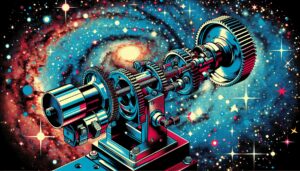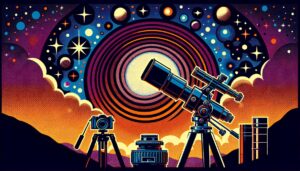This site contains affiliate links to products. I may receive a commission for purchases made through these links.
An 80mm refractor telescope is great for observing detailed images of the Moon and planets. You can see the lunar surface craters in good detail and even the four Galenian moons of Jupiter with an 80mm refractor. You can also pan around the Milky Way and deep sky objects.
Let’s delve into what you can expect to see through the lens of an 80mm refractor, highlighting its capabilities and the types of celestial objects within its reach.
Observing planets with an 80mm refractor
An 80mm telescope is great for observing the bright planets of the solar system:
Venus
This bright planet is frequently seen in the sky during the day and exhibits phases, like the Moon, when viewed through a telescope. If you observe it at the right time, you can see it change in size, like the Moon, using an 80mm refracting telescope.
Mars
This red planet can be seen in the dark skies and will show details such as polar ice caps and dark surface markings with an 80mm refractor.
Jupiter
The planet can show its cloud bands, Great Red Spot, and four Galilean Moons through an 80mm aperture lens. As the planet rotates on its axis every 10 hours, you can always try again in 10 hours if you miss the GRS.
Saturn
The planet is famous for its rings, which can be seen in detail through an 80mm refractor. With the telescope, you can also see the planet’s largest Moon, Titan, if there is not much light pollution around.
Keep in mind that the actual visibility of these planets depends on several factors, such as the time of year, the observing location, and the quality of the telescope and eyepieces.
Observing the moon with an 80mm refractor
As the Moon is closer to the Earth than any of the planets, you can see the satellite in stunning detail with an 80mm telescope. Here are a few details you will be able to observe:
Craters of the Moon
The Moon is pocked with countless craters of various sizes, created by impact from asteroids and comets. The largest craters, such as Tycho and Copernicus, can be easily seen through the telescope.
Mountain ranges
The Moon’s rugged terrain includes several large mountain ranges, such as the Apennines and the Montes Carpatus. These features can be seen in detail with an 80mm aperture lens, especially near the terminator, where the sunlight is angled to create shadows and highlight the topography.
Vallis and Rilles
The Moon’s surface also includes deep valleys and sinuous channels known as Vallis and rilles. These features were created by volcanic or tectonic activity and provide clues about the Moon’s geological history. Using an 80mm refractor, you can also look at them.
Lunar Maria
The dark, flat regions on the Moon’s surface are known as Lunar Maria. These areas were formed by ancient volcanic eruptions and appear dark due to the presence of basaltic rock. You can see these in great detail with your home telescope if you are patient enough. With an 80mm refractor, you can enjoy the beauty of the Moon’s surface and learn about its fascinating geology and history.
Observing star clusters, nebulas, and deep-sky objects with an 80mm refractor
Your 80mm telescope can be great for seeing several bright stars in the night sky. Here are a few notable objects that you can see using an 80mm refractor telescope:
Globular clusters
The 80mm telescope can reveal several bright and dense star clusters, such as the Pleiades, the Hyades, and the Double Cluster in Perseus. These open clusters offer a glimpse into the distribution of stars in the Milky Way galaxy and their evolution.
Nebula
The 80mm refractor can also show several bright and colorful deep sky nebulae, such as the Orion Nebula (M42), the Dumbbell Nebula (M27), and the Ring Nebula (M57). The nebulae are clouds of gas and dust where stars form and provide a fascinating view of the universe’s ongoing star formation and evolution processes.
Double Stars
The telescope can also reveal several interesting binary star systems, where two stars are in close orbit around each other. These double stars can be seen as two separate points of light, and observing them can offer a glimpse into the dynamics of binary star systems.
Observing galaxies in the night sky with an 80mm refractor
You can see distant galaxies and celestial objects with your 80mm telescope. One of the most famous galaxies, Andromeda, can also be seen using an 80mm aperture lens.
However, observing the Andromeda Galaxy with a nice telescope of this size can be challenging because of its distance (over 2 million light-years away) and size (over 200,000 light-years across). In most small telescopes, it appears like a hazy patch.
To get the best view of the Andromeda Galaxy, you should find a dark location with minimal light pollution and use a tripod to stabilize the telescope.
Observing meteor showers with an 80mm refractor
While you can theoretically use an 80mm aperture small telescope to see meteor showers, it is not the best tool. Meteor showers move too quickly across the sky to be followed by the telescope.
Instead, a wide-field view of the dark sky is better for observing meteor showers, so using the naked eye or binoculars is better.
Observing lunar and solar eclipses with an 80mm refractor
Your 80mm telescope based on refraction can be a great way to observe lunar and solar eclipses. However, it’s important to note that observing a solar eclipse requires special precautions to avoid damaging your eyes or the telescope.
A solar aperture filter, which reduces the amount of light and harmful radiation from the Sun, must be used when observing a solar eclipse with a nice telescope.
On the other hand, observing a lunar eclipse is safe and can provide a great opportunity to see the Moon in different lighting conditions. An 80mm telescope can provide a good view of the Moon and the shadows cast during a lunar eclipse.
Can I see the rings of Saturn with an 80mm telescope?
An 80mm telescope is a common choice for observing Saturn’s rings, and it can provide a decent view of the planet and its rings. Saturn is one of the most recognizable and fascinating planets in our Solar System, and observing its stunning ring system is a popular hobby for amateur astronomers.
However, there are other factors to consider when using this type of telescope to observe Saturn, and the results can vary depending on the conditions and the observer’s skills.
Size of the planet and rings
The first thing to consider when observing Saturn with an 80mm telescope is the planet’s size and rings. Saturn is much smaller than other objects in the dark skies, and its rings are relatively thin, so they can be challenging to see, especially with a smaller telescope.
The size of the 80mm telescope is sufficient to see the planet and its rings, but the fine details of the rings will not be as clear as they would be with a larger telescope.
The magnification
The second factor to consider is the magnification of the telescope. The magnification power is determined by the eyepiece used, and the 80mm telescope can be fitted with various eyepieces to increase or decrease the magnification.
When observing Saturn, you should use a low magnification eyepiece, as this will provide a wider field of view and help you find the planet. Once the planet is found, you can use a high-magnification eyepiece to see the surface details of the rings.
Observing conditions
The third factor to consider is the stability of the telescope and the observing conditions. The telescope’s stability is important when observing Saturn, as even small movements can blur the image.
A sturdy tripod and a steady hand can help minimize vibrations and improve the telescope’s stability. Additionally, observing conditions also play a crucial role in the quality of the view.
Clear, dark skies with minimal light pollution are ideal for observing Saturn and its rings. When the air is still, the image will be clearer, and when the air is turbulent, the image will be less clear.
What are the advantages of an 80mm refractor?
An 80mm refractor is an excellent beginner’s telescope with several advantages, including the following.
Light gathering ability
One of the main advantages of the 80mm refractor is its aperture, which refers to the diameter of its objective lens. The 80mm aperture provides a good balance between portability and light-gathering ability, allowing you to see a wide range of objects in the dark skies, including the Moon, planets, and many stars.
In addition, the 80mm refractor has a relatively long focal length, which helps to magnify the light gathered by the aperture and produce a clear and detailed image.
Versatility
An 80mm small telescope is a versatile instrument in amateur astronomy. It is compact, easy to set up and transport, and offers a decent aperture for observing celestial objects such as the Moon, planets, the milky way, and bright deep-sky objects.
The versatility of this refractor size also allows various accessories to be used, such as different eyepieces to achieve different magnifications, Barlow lenses to increase the magnification of an eyepiece, and cameras to capture images.
Durability
An 80mm refractor is generally considered durable if properly handled and stored. The telescope is made of metal and glass, durable materials that can withstand normal use.
Portability
The typical 80mm refractor has a length of about 600-800mm and weighs 2-4 kilograms, making it easy to carry and move around and a great option for amateur astronomers. Besides, most small telescopes come with a smartphone adapter to make it easy to take beautiful photographs.
Cost-effectiveness
An 80mm refractor can be considered cost-effective compared to a larger telescope, as it offers a decent aperture size for its relatively low cost. Refractor telescopes are known for their high optical quality and durability, making them a good value for the money.
What are the disadvantages of an 80mm refractor?
While 80mm is a great aperture size for a telescope, it has its share of disadvantages, including the following.
Limitations in magnification
The magnification of a telescope is limited by the aperture size and the eyepiece used. In the case of an 80mm refractor, the maximum practical magnification is about 150x to 200x. Going beyond this magnification can result in a dim, blurred image due to the limitations of the aperture size.
Difficulty in viewing faint objects
Viewing faint objects, such as distant galaxies and open clusters, can be difficult with an 80mm refractor due to its limited aperture size. A smaller aperture means less light is gathered, making the image dimmer, less detailed, and often having false color.
Best 80mm refractor telescope for astrophotography
There are several good quality 80mm refractor telescopes on the market. Let’s take a look at the best three below.
Gskyer Telescope 80400 – best for beginners
The Gskyer Telescope 80400 is one of the best 80mm refractor telescopes for beginners. It comes with an Altazimuth Mount and has a focal length of 400mm, making it great for observing stars, planets, and the Moon. It has three eyepiece lenses (16X, 40X, 80X), a 3X Barlow lens, and a smartphone adapter.
HEXEUM 80mm Aperture – best value
The HEXEUM 80mm Aperture is one of the market’s most pocket-friendly 80mm telescopes that packs in quite a punch. The telescope’s optics are also superior, with a 600mm focal length (f/6.7) to capture light even from the faintest planetary nebulae and binary stars. If you want to purchase a telescope on a budget, then the HEXIUM won’t disappoint you.
Celestron AstroMaster 80AZS – best overall
The Celestron AstroMaster 80AZS is a user-friendly 80mm telescope with a smartphone adapter. The telescope features fully coated glass optics for superior clarity and comes with two eyepieces. The telescope also comes with StarPointer red dot finder scope and an adjustable tripod, making it an excellent all-rounder telescope.
Takeaway: Unleash the cosmic adventure with a portable 80mm refractor telescope
An 80mm refractor telescope can be a good option for astronomy enthusiasts looking for a compact, portable, and cost-effective telescope.
With its small size and lightweight design, this type of telescope is easy to transport and set up, making it a great option for observing on the go. The high optical quality of refractor telescopes and the durability of the metal and glass components make them a good value for the money.
You can observe several celestial bodies like the Moon, planets, galaxies, and nebulae in great detail with this telescope.
Read also:








